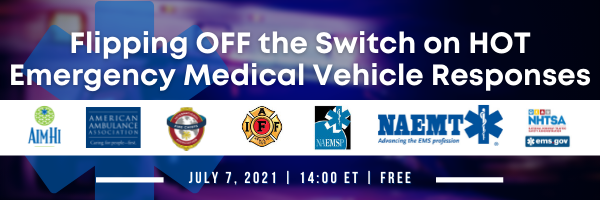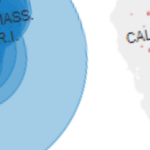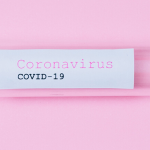EMS.gov | Template Protocol for EMS Administration of Monoclonal Antibodies
From EMS.gov on August 27, 2021
To assist EMS agencies in planning, the NHTSA Office of EMS and HHS Office of the Assistant Secretary for Preparedness and Response have developed a template protocol for state EMS offices and EMS Medical Directors to use to assist in these programs. Some states have created blanket state-level authorizations for EMS administration; some states will still require provider authorization prior to administration. Please follow local protocols and regulations. This template is only designed to facilitate the development of those local protocols as needed. Please contact the NHTSA Office of EMS with any questions.
EMS.gov | Information About COVID-19 for EMS Systems and Clinicians
From EMS.gov
|
|
Monkeypox & COVID-19 Resources for EMS Clinicians
From EMS.Gov
Monkeypox Resources for EMS Clinicians
The arrival of an individual in the United States who was diagnosed with monkeypox, as well as the uptick in COVID-19 cases, are reminders that EMS clinicians must remain vigilant and prepared. The CDC is conducting contact tracing of the monkeypox case and local public health departments have been notified, and it is unlikely that EMS clinicians will be exposed to the monkeypox virus is low. However, reviewing information about the disease may still be helpful.
COVID-19 Resources for EMS
Low vaccination rates, the highly contagious delta variant, and increased social interaction has caused significant increases in rates of COVID-19 and related hospitalizations in many communities around the nation. The NHTSA Office of EMS continues to make resources available to help EMS clinicians, organizations and regulators safely maintain operations during the pandemic. Those resources are available on the EMS.gov COVID-19 Resources Page.
EICC Pediatric Emergency Champion Program
From the Emergency Medical Services for Children Innovation and Improvement Center
September 1, 2021 – June 30, 2022
Purpose
This collaborative will develop individuals who are interested in improving the quality of pediatric care at your EMS agency, ED/hospital, or within your region. We will provide resources, example practices and networking opportunities at no cost to help push forward any effort for pediatric improvement.
What is a PECC?
A Pediatric Emergency Care Coordinator (PECC)–sometimes referred to as a pediatric champion or pediatric liaison–is a term that the EMSC program uses to refer to any individual who has a particular interest in or responsibilities related to pediatric emergency care. Sometimes this individual is dedicated solely to this role. However, depending on the pediatric volume of the EMS agency or hospital, this person may take on the PECC duties in addition to other responsibilities (e.g., educator, trauma coordinator, etc.). Various roles and responsibilities are often given to a PECC but common responsibilities include ensuring the availability of pediatric equipment, supplies and medications, pediatric education/training and advocating for pediatric considerations to be included in protocol/policy development.
Who should participate
Anyone that is interested in improving pediatric readiness within your EMS agency, ED/hospital, or within your region, to include EMSC State Partnership Programs. You do NOT need to have any formal pediatric training, or a title related to pediatric care. You already have everything you need to participate…an interest in pediatric emergency care
Why join?
We know that the presence of an individual with an interest in pediatric emergency care is strongly correlated with improved outcomes for children. No effort to improve pediatric emergency care is too small to make an impact. This collaborative will have a broad scope. No matter where your starting point is, we will provide you with tools to improve. There is no cost to participate, and you will have the opportunity to earn continuing education or Maintenance of Certification Part 4 credit. Learn more…
How it works
The collaborative will occur in two parts. During the first half, we will explore seven pediatric readiness areas of focus, evaluate your agency or ED/hospital level of pediatric readiness, and identify areas for improvement. In the second half, we provide coaching and tools to help you develop an improvement project. Learn more…
Location
All collaborative activates will be conducted online and through virtual meetings.
Study | Increasing Pediatric Care Coordination and Psychomotor Skills Evaluation
Thank you to Dr. John Russell of Cape County Private Ambulance for sharing this resource.
Ready for Children Part II: Increasing Pediatric Care Coordination and Psychomotor Skills Evaluation in the Prehospital Setting
(2021) Ready for Children Part II: Increasing Pediatric Care Coordination and Psychomotor Skills Evaluation in the Prehospital Setting, Prehospital Emergency Care, DOI: 10.1080/10903127.2021.1942340
Abstract
Objectives: Treating pediatric patients often invokes discomfort and anxiety among emergency medical service (EMS) personnel. As part of the process to improve pediatric care in the prehospital system, the Health Resources and Services Administration (HRSA) Emergency Services for Children (EMSC) Program implemented two prehospital performance measures -access to a designated pediatric care coordinator (PECC) and skill evaluation using pediatric equipment-along with a multi-year plan to aid states in achieving the measures. Baseline data from a survey conducted in 2017 showed that less than 25% of EMS agencies had access to PECC and 47% performed skills evaluation using pediatric equipment at least twice a year. To evaluate change over time, the survey was again conducted in 2020, and agencies that participated in both years are compared.
Methods: A web-based survey was sent to EMS agency administrators in 58 states and territories from January to March 2020. Descriptive statistics, odds ratios, and 95% confidence intervals were conducted.
Results: The response rate was 56%. A total of 5,221 agencies participated in both survey periods representing over 250,000 providers. The percentage of agencies reporting the presence of a PECC increased from 24% to 34% (p= <0.001). However, some agencies reported that they no longer had a PECC, while others reported having a PECC for the first time. Fifty percent (50%) of agencies conduct pediatric psychomotor skills evaluation at least twice/year, a 2% increase over time (p = 0.041); however, a third (34%) evaluate skills using pediatric equipment less than once a year. The presence of a PECC continues to be the variable associated with the highest odds (AOR 2.15, 95% CI 1.91–2.43) of conducting at least semiannual skills evaluation.
Conclusions: There is an increase in the presence of pediatric care coordination and the frequency of pediatric psychomotor skills evaluation among national EMS agencies over time. Continued efforts to increase and sustain PECC presence should be an ongoing focus to improve pediatric readiness in the prehospital system.
EMS.gov | New Resources Help EMS Clinicians and Agencies Navigate HIPAA
Nationwide, EMS agencies regularly report that hospitals and other healthcare workers refuse to share patient information with them, citing Health Insurance Portability and Accountability Act (HIPAA) concerns. Misconceptions about HIPAA can create artificial barriers to the legitimate, approved exchange of data between EMS and other providers, resulting in missed opportunities to improve patient outcomes and advance evidence-based practices in prehospital care.
To address this issue, the NEMSIS Technical Assistance Center collaborated with the law firm Page, Wolfberg & Wirth to provide helpful resources explaining the sharing of patient information between EMS and other healthcare professionals:
- HIPAA Basics for EMS Practitioners – This poster provides HIPAA guidance relevant to EMS clinicians, including tips for accessing and sharing protected health information across a variety of situations.
- HIPAA: An Imaginary Barrier to Data Exchange – This white paper discusses why HIPAA does not restrict the bidirectional patient information sharing but actually promotes the sharing of patient information between hospitals or other healthcare entities and EMS agencies.
- Short Legal Opinion: Sharing Patient Data Bidirectionally Under HIPAA – Developed specifically for healthcare administrators, legal counsel, and risk management, this brief legal opinion describes how sharing of patient information is not only allowed but encouraged under HIPAA.
- Detailed Legal Opinion: HIPAA Concerns About Releasing Information for NEMSIS – This legal opinion provides detailed analysis of HIPAA issues related to the sharing of patient information with entities involved in the administration of the National EMS Information System.
While obstacles may remain for the appropriate sharing of patient information, HIPAA is not one of them. Sharing patient information benefits EMS agencies and improves prehospital patient care by revealing evidence-based practices that make a difference for patients in the field.
On-Demand | Flipping OFF the Switch on HOT Emergency Medical Vehicle Responses!
.png) Flipping OFF the Switch on HOT Emergency Medical Vehicle Responses!
Flipping OFF the Switch on HOT Emergency Medical Vehicle Responses!
Recorded July 7, 2021 | 14:00–15:15 pm ET | FREE Webinar
Download Slide Deck | Watch on YouTube
HOT (red light and siren) responses put EMS providers and the public at significant risk. Studies have demonstrated that the time saved during this mode of vehicle operation and that reducing HOT responses enhances safety of personnel, with little to no impact on patient outcomes. Some agencies have ‘dabbled’ with responding COLD (without lights and sirens) to some calls, but perhaps none as dramatic as Niagara Region EMS in Ontario, Canada – who successfully flipped their HOT responses to a mere 10% of their 911 calls! Why did they do it? How did they do it? What has been the community response? What has been the response from their workforce? Has there been any difference in patient outcomes? Join Niagara Region EMS to learn the answers to these questions and more. Panelists from co-hosting associations will participate to share their perspectives on this important EMS safety issue!
Speakers
Kevin Smith, BAppB:ES, CMM III, ACP, CEMC
Chief
Niagara Emergency Medical Services
Jon R. Krohmer, MD, FACEP, FAEMS
Director, Office of EMS
National Highway Traffic Safety Administration
Team Lead, COVID-19 EMS/Prehospital Team
Douglas F. Kupas, MD, EMT-P, FAEMS, FACEP
Medical Director, NAEMT
Medical Director, Geisinger EMS
Matt Zavadsky, MS-HSA, NREMT
Chief Strategic Integration Officer
MedStar Mobile Integrated Healthcare
Bryan R. Wilson, MD, NRP, FAAEM
Assistant Professor of Emergency Medicine
St. Luke’s University Health Network
Medical Director, City of Bethlehem EMS
Robert McClintock
Director of Fire & EMS Operations
Technical Assistance and Information Resources
International Association of Fire Fighters
Mike McEvoy, PhD, NRP, RN, CCRN
Chair – EMS Section Board – International Association of Fire Chiefs
EMS Coordinator – Saratoga County, New York
Chief Medical Officer – West Crescent Fire Department
Professional Development Coordinator – Clifton Park & Halfmoon EMS
Cardiovascular ICU Nurse Clinician – Albany Medical Center
Facility Contract Template for EMS
Please either or Join!
FDA | EUAs for KN95s, Certain Other Respirators Revoked
FDA In Brief: FDA Revokes Emergency Use Authorizations for Certain Respirators and Decontamination Systems as Access to N95s Increases Nationwide
The following quote is attributed to Suzanne Schwartz, M.D., M.B.A., director of the Office of Strategic Partnerships and Technology Innovation in the FDA’s Center for Devices and Radiological Health
“Throughout the pandemic, the FDA has worked closely with our federal partners at the Centers for Disease Control and Prevention’s National Institute for Occupational Safety and Health (NIOSH), the Occupational Safety and Health Administration (OSHA) and with manufacturers to protect our front-line workers by facilitating access to the medical supplies they require. As a result of these efforts, our country is now better positioned to provide health care workers with access to NIOSH-approved N95s rather than using non-NIOSH-approved respirators or reusing decontaminated disposable respirators.
Early in the public health emergency, there was a need to issue emergency use authorizations (EUAs) for non-NIOSH-approved respirators as well as decontamination and bioburden reduction systems to disinfect disposable respirators. Today, those conditions no longer exist. Our national supply of NIOSH-approved N95s is more accessible to our health care workers every day.
Today, the FDA is taking additional action by announcing the revocation of EUAs for imported, non-NIOSH-approved respirators as well as decontamination and bioburden reduction systems because of an increase in domestically-manufactured NIOSH-approved N95s available throughout the country. As access to domestic supply of disposable respirators continues to significantly improve, health care organizations should transition away from crisis capacity conservation strategies that were implemented at the onset of the pandemic.”
Additional Information
- The U.S. Food and Drug Administration announced it is revoking EUAs of all non-NIOSH (National Institute of Occupational Safety and Health)-approved disposable respirators, which includes imported disposable respirators such as KN95s, along with revoking EUAs for decontamination and bioburden reduction systems.
- Today’s actions are consistent with the Centers for Disease Control and Prevention’s (CDC) updated recommendations that health care facilities not use crisis capacity strategies and should promptly return to conventional practices. They are also consistent with the Occupational Safety and Health Administration’s (OSHA) recently published Emergency Temporary Standard (ETS) to protect health care workers, which requires health care employers to provide NIOSH-approved or FDA-authorized respirators for workers potentially exposed to COVID-19.
- All manufacturers of decontamination and bioburden reduction systems have requested, and the FDA has proceeded with, the revocation of their EUAs, effective June 30, 2021.
- Since the beginning of the pandemic, NIOSH has approved more than 875 respirator models or configurations, with some of these manufactured by approximately 20 new, domestic NIOSH-approval holders. In addition, as of today, there are more than 6,400 total respirator models or configurations on the NIOSH-certified equipment list which have met the NIOSH-approved EUA criteria and thus are FDA-authorized. These include:
- more than 600 filtering facepiece respirator (FFR) models (of which there are over 530 N95 FFR models),
- more than 5,500 elastomeric respirator configurations, including new elastomeric respirators without an exhalation valve, and
- more than 360 powered air purifying respirator configurations.
- Today’s EUA revocations announcement for all non-NIOSH approved disposable FFRs follows earlier actions to limit authorization of imports of non-NIOSH-approved filtering facepiece respirators, imports of non-NIOSH approved filtering facepiece respirators manufactured in China, and decontamination and bioburden reduction systems for disposable respirators.
- FDA has also withdrawn two related decontamination and bioburden reduction guidance documents:
- Recommendations for Sponsors Requesting EUAs for Decontamination and Bioburden Reduction Systems for Face Masks and Respirators During the Coronavirus Disease 2019 (COVID-19) Public Health Emergency: Guidance for Industry and Food and Drug Administration Staff
- Enforcement Policy for Bioburden Reduction Systems Using Dry Heat to Support Single-User Reuse of Certain Filtering Facepiece Respirators During the Coronavirus Disease (2019) Public Health Emergency
- The FDA recommends health care personnel transition from extended use of disposable respirators to single-use for single-patient interactions as appropriate. See the letter to health care personnel for additional information.
###
The FDA, an agency within the U.S. Department of Health and Human Services, protects the public health by assuring the safety, effectiveness, and security of human and veterinary drugs, vaccines and other biological products for human use, and medical devices. The agency also is responsible for the safety and security of our nation’s food supply, cosmetics, dietary supplements, products that give off electronic radiation, and for regulating tobacco products.
Inquiries
- Media:
- Shirley Simson
- 202-597-4230
- Consumer:
- 888-INFO-FDA
NEMSIS | EMS Body Cam Guide
New Guide Offers Body-Worn Camera Legal Considerations for EMS Agencies
Although body-worn cameras aren’t yet widely used in EMS, interest is growing and organizations that have employed them have seen significant benefits – and some limitations.
To help guide agencies, the National Emergency Medical Services Information System Technical Assistance Center (NEMSIS TAC), in cooperation with the legal firm Page, Wolfberg & Wirth, has released the EMS Body-worn Camera Quickstart Guide: Legal Considerations for EMS Agencies. The guide provides an overview of general legal issues for EMS agencies thinking about using body-worn cameras.
An overview of these key legal considerations for EMS agencies are covered in the new document:
- Federal HIPAA standards
- State invasion of privacy laws
- State wiretap/eavesdropping laws
- State open records laws
- Data retention requirements
- Developing a body-worn camera policy
Every EMS agency considering the use of body-worn cameras must evaluate not just legal issues but financial considerations, public perception, impact on staff, potential union bargaining and more.
Webinar | Ambulance Fleet Tips for Weathering the Chassis Shortage
Ambulance Fleet Tips for Weathering the Chassis Shortage
Webinar | June 23, 2021 | 14:00 ET | Free to AAA Members
The American Ambulance Association and the Commission on Accreditation of Ambulance Services recently reported that a global semiconductor shortage has crippled the production of motor vehicle chassis—including those used by ambulance manufacturers and remounters. Ford Motor Company, which supplies approximately 70% of the ambulance chassis used in the US, halted production in mid-April. The end is not yet in sight, with the shortage of the critically important microchips predicted to run into 2022.
Join ambulance fleet experts from across the country to learn what your EMS agency can do NOW to extend the lifecycle of your vehicles and minimize the impact of the chip and chassis shortage. Additionally, learn how the American Ambulance Association is working to drive federal, state, and local advocacy efforts to ensure that first responders are at the front of the line when production resumes. Don’t miss your chance to learn from ambulance fleet luminaries how they keep their crews rolling, 24/7!
Speakers
Drew Morrow
Director of Support Services, Pro EMS
Mark Van Arnam
Administrator, CAAS GVS
Maria Bianchi
CEO, American Ambulance Association
Trampus Gaspard
Senior Director of Logistics, Acadian Companies
HHS ASPR Project ECHO COVID-19 Clinical Rounds
HHS Office of the Assistant Secretary for Preparedness and Response

- Peer to Peer Sharing : HHS ASPR, Project ECHO, and the National Emerging Special Pathogens Training and Education Centers (NETEC) together support the COVID-19 Clinical Rounds, peer to peer real-time knowledge sharing sessions among front line clinicians on challenges and successes encountered treating COVID-19.
- Audience of Multidisciplinary Clinicians: Physicians, nurses, and EMS clinicians participate in the Rounds, which continue to focus on critical care, emergency departments, and EMS.
- Format of Sessions: Each Clinical Rounds session includes brief presentations from experienced expert clinicians complemented by discussion among expert panelists in response to Q&A from participants.
- Sharing of Experience, Not Official Guidance: Rounds are intended to be the sharing of clinical experience rather than formal recommendations or guidance.
- Evolving Clinical Round Topics: Topics of Clinical Rounds evolve to address the dynamic COVID-19 medical response.
- Continuing Medical Education (CME) Credit: Participants can fill out a short survey and receive 1 hour of Continuing Medical Education credit instantly for each session.
EMS.gov | Telemedicine Framework for EMS and 911
|
|
|
CMS Bolsters Payments for At-Home COVID-19 Vaccines
From CMS on June 9, 2021
Biden Administration Continues Efforts to Increase Vaccinations by Bolstering Payments for At-Home COVID-19 Vaccinations for Medicare Beneficiaries
As part of President Biden’s commitment to increasing access to vaccinations, CMS announced an additional payment amount for administering in-home COVID-19 vaccinations to Medicare beneficiaries who have difficulty leaving their homes or are otherwise hard-to-reach. This announcement further demonstrates continued efforts of the Biden-Harris Administration to meet people where they are and make it as easy as possible for all Americans to get vaccinated. There are approximately 1.6 million adults 65 or older who may have trouble accessing COVID-19 vaccinations because they have difficulty leaving home.
While many Medicare beneficiaries can receive a COVID-19 vaccine at a retail pharmacy, their physician’s office, or a mass vaccination site, some beneficiaries have great difficulty leaving their homes or face a taxing effort getting around their communities easily to access vaccination in these settings. To better serve this group, Medicare is incentivizing providers and will pay an additional $35 per dose for COVID-19 vaccine administration in a beneficiary’s home, increasing the total payment amount for at-home vaccination from approximately $40 to approximately $75 per vaccine dose. For a two-dose vaccine, this results in a total payment of approximately $150 for the administration of both doses, or approximately $70 more than the current rate.
“CMS is committed to meeting the unique needs of Medicare consumers and their communities – particularly those who are home bound or who have trouble getting to a vaccination site. That’s why we’re acting today to expand the availability of the COVID-19 vaccine to people with Medicare at home,” said CMS Administrator Chiquita Brooks-Lasure. “We’re committed to taking action wherever barriers exist and bringing the fight against the COVID-19 pandemic to the door of older adults and other individuals covered by Medicare who still need protection.”
Delivering COVID-19 vaccination to access-challenged and hard-to-reach individuals poses some unique challenges, such as ensuring appropriate vaccine storage temperatures, handling, and administration. The CDC has outlined guidance to assist vaccinators in overcoming these challenges. This announcement now helps to address the financial burden associated with accommodating these complications.
The additional payment amount also accounts for the clinical time needed to monitor a beneficiary after the vaccine is administered, as well as the upfront costs associated with administering the vaccine safely and appropriately in a beneficiary’s home. The payment rate for administering each dose of a COVID-19 vaccine, as well as the additional in-home payment amount, will be geographically adjusted based on where the service is furnished.
How to Find a COVID-19 Vaccine:
As this action demonstrates, a person’s ability to leave their home should not be an obstacle to getting the COVID-19 vaccine. As states and the federal government continue to break down barriers – like where vaccines can be administered – resources for connecting communities to vaccination options remain key. Unvaccinated individuals and those looking to assist friends and family can:
- Visit vaccines.gov (English) or vacunas.gov (Spanish) to search for vaccines nearby
- Text GETVAX (438829) for English or VACUNA (822862) for Spanish for near-instant access to details on three vaccine sites in the local area
- Call the National COVID-19 Vaccination Assistance Hotline at 1-800-232-0233 (TTY: 1-888-720-7489) for assistance in English and Spanish
Coverage of COVID-19 Vaccines:
The federal government is providing the COVID-19 vaccine free of charge or with no cost-sharing for all people living in the United States. As a condition of receiving free COVID-19 vaccines from the federal government, vaccine providers cannot charge patients any amount for administering the vaccine.
Because no patient can be billed for COVID-19 vaccinations, CMS and its partners have provided a variety of information online for providers vaccinating all Americans regardless of their insurance status:
- Original Medicare and Medicare Advantage: Beneficiaries with Medicare pay nothing for COVID-19 vaccines or their administration, and there is no applicable copayment, coinsurance or deductible.
- Medicaid and the Children’s Health Insurance Program (CHIP):State Medicaid and CHIP agencies must cover COVID-19 vaccine administration with no cost sharing for nearly all beneficiaries during the COVID-19 Public Health Emergency (PHE) and for over a year after it ends. For the very limited number of Medicaid beneficiaries who are not eligible for this coverage (and do not receive it through other coverage they might have), providers may submit claims for reimbursement for administering the COVID-19 vaccine to underinsured individuals through the COVID-19 Coverage Assistance Fund, administered by the Health Resources and Services Administration (HRSA), as discussed below. Under the American Rescue Plan Act of 2021 (ARP), signed by President Biden on March 11, 2021, the federal matching percentage for state Medicaid and CHIP expenditures on COVID-19 vaccine administration is currently 100% (as of April 1, 2021), and will remain 100% for more than a year after the COVID-19 PHE ends. The ARP also expands coverage of COVID-19 vaccine administration under Medicaid and CHIP to additional eligibility groups. CMS recently updated the Medicaid vaccine toolkit to reflect the enactment of the ARP at https://www.medicaid.gov/state-resource-center/downloads/covid-19-vaccine-toolkit.pdf.
- Private Plans: The vaccine is free for people enrolled in private health plans and issuers COVID-19 vaccine and its administration is covered without cost sharing for most enrollees, and such coverage must be provided both in-network and out-of-network during the PHE. Current regulations provide that out-of-network rates must be reasonable as compared to prevailing market rates, and the rules reference using the Medicare payment rates as a potential guideline for insurance companies. In light of CMS’s increased Medicare payment rates, CMS will expect health insurance issuers and group health plans to continue to ensure their rates are reasonable when compared to prevailing market rates. Under the conditions of participation in the CDC COVID-19 Vaccination Program, providers cannot charge plan enrollees any administration fee or cost sharing, regardless of whether the COVID-19 vaccine is administered in-network or out-of-network.
The Biden-Harris Administration is providing free access to COVID-19 vaccines for every adult living in the United States. For individuals who are underinsured, providers may submit claims for reimbursement for administering the COVID-19 vaccine through the COVID-19 Coverage Assistance Fund administered by HRSA after the claim to the individual’s health plan for payment has been denied or only partially paid. Information is available at https://www.hrsa.gov/covid19-coverage-assistance.
For individuals who are uninsured, providers may submit claims for reimbursement for administering the COVID-19 vaccine to individuals without insurance through the Provider Relief Fund, administered by HRSA. Information on the COVID-19 Claims Reimbursement to Health Care Providers and Facilities for Testing, Treatment, and Vaccine Administration for the Uninsured Program is available at https://www.hrsa.gov/CovidUninsuredClaim.
More information on Medicare payment for COVID-19 vaccine administration – including a list of billing codes, payment allowances and effective dates – is available at https://www.cms.gov/medicare/covid-19/medicare-covid-19-vaccine-shot-payment.
More information regarding the CDC COVID-19 Vaccination Program Provider Requirements and how the COVID-19 vaccine is provided through that program at no cost to recipients is available at https://www.cdc.gov/vaccines/covid-19/vaccination-provider-support.html.
JEMS | Quality of Handoffs from EMS to ED
Quality of Handoffs from Emergency Medical Services to Emergency Department Providers
Literature and study team experience indicate emergency medical services (EMS) to emergency department provider handoffs could be an opportunity for improvement in emergency medical care. To date, no study has been published to specifically determine the perceived quality of handoffs between EMS and emergency department providers in the state of Minnesota. This exploratory project could help provide insight toward improving handoffs and guide future research and quality improvement projects.
Webinar 7/7 | Lights & Sirens Responses

Flipping OFF the Switch on HOT Emergency Medical Vehicle Responses!
Free Webinar July 7 | 14:00–15:15 ET
HOT (red light and siren) responses put EMS providers and the public at significant risk. Studies have demonstrated that the time saved during this mode of vehicle operation and that reducing HOT responses enhances safety of personnel, with little to no impact on patient outcomes. Some agencies have ‘dabbled’ with responding COLD (without lights and sirens) to some calls, but perhaps none as dramatic as Niagara Region EMS in Ontario, Canada – who successfully flipped their HOT responses to a mere 10% of their 911 calls! Why did they do it? How did they do it? What has been the community response? What has been the response from their workforce? Has there been any difference in patient outcomes? Join Niagara Region EMS to learn the answers to these questions and more. Panelists from co-hosting associations will participate to share their perspectives on this important EMS safety issue!
Speakers
Kevin Smith, BAppB:ES, CMM III, ACP, CEMC
Chief
Niagara Emergency Medical Services
Jon R. Krohmer, MD, FACEP, FAEMS
Team Lead, COVID-19 EMS/Prehospital Team
Director, Office of EMS
National Highway Traffic Safety Administration
Douglas F. Kupas, MD, EMT-P, FAEMS, FACEP
Medical Director, NAEMT
Medical Director, Geisinger EMS
Matt Zavadsky, MS-HSA, NREMT
Chief Strategic Integration Officer
MedStar Mobile Integrated Healthcare
Bryan R. Wilson, MD, NRP, FAAEM
Assistant Professor of Emergency Medicine
St. Luke’s University Health Network
Medical Director, City of Bethlehem EMS
Robert McClintock
Director of Fire & EMS Operations
Technical Assistance and Information Resources
International Association of Fire Fighters
Mike McEvoy, PhD, NRP, RN, CCRN
Chair – EMS Section Board – International Association of Fire Chiefs
EMS Coordinator – Saratoga County, New York
Chief Medical Officer – West Crescent Fire Department
Professional Development Coordinator – Clifton Park & Halfmoon EMS
Cardiovascular ICU Nurse Clinician – Albany Medical Center
ABC | Global microchip shortage impacting ambulance supply
May 21, 2021 | By Mina Kaji and Amanda Maile | Read Full Story
“Without those chassis, the production of ambulances essentially slows down dramatically,” American Ambulance Association Spokesman Mark Van Arnam said. “So that becomes a public safety issue.”
Chassis inventories were already at “historically low levels” due to coronavirus shutting down manufacturing plants, Van Arnam explained.
In order to make an ambulance, manufacturers need to first construct a chassis, or frame, to build it on.
“An ambulance chassis contains dozens and dozens of microchips — more microchips than the average F-150,” Van Arnam said.
CMS | Medicare COVID-19 Data Snapshot
Today, the Centers for Medicare & Medicaid Services (CMS) released our monthly update of data that provides a snapshot of the impact of COVID-19 on the Medicare population. The updated data show over 4.1 million COVID-19 cases among the Medicare population and over 1.1 million COVID-19 hospitalizations.
The updated snapshot covers the period from January 1, 2020 to March 20, 2021. It is based on Medicare Fee-for-Service claims and Medicare Advantage encounter data CMS received by April 16, 2021.
Microchip Shortage to Affect Ambulance Supply
From the American Ambulance Association & The Commission on Accreditation of Ambulance Services (CAAS) Ground Vehicle Standards
By Mark Van Arnam, Administrator, CAAS GVS
A global semiconductor shortage is crippling the production of motor vehicles both in the US and worldwide. Ford Motor Company, which supplies approximately 70% of the ambulance chassis used in the US, shut down production at various plants that produce the E series, T series, and F series ambulance chassis in mid-April. These scheduled shutdowns continue and are already approaching the 6 to 7-week mark. The end is not yet in sight, with the shortage of the critical microchips predicted to run into 2022. Ford currently predicts an overall production loss of over 1.1 million units in 2021.
These production shutdowns by Ford and other chassis manufacturers have created a major supply chain interruption of chassis needed to produce ambulances in North America. Many Final Stage Ambulance Manufacturers (FSAMs) and Remounters are reporting chassis shortages that are worse than those experienced in the 2020 pandemic period when those OEM truck plants shut down for COVID reasons.
Both Ford and GM report that the duration and extent of the semiconductor shortage and resulting production shutdowns are not yet known and “the situation changes daily”. As of mid-May, many FSAMs are reporting significant ambulance production slowdowns due to chassis shortages, with complete shutdowns of some ambulance assembly lines highly likely in the near future.
Study | EMS Super-Utilizers
The Penn State College of Medicine is conducting a national study of social needs in EMS patients, particularly in regards to potential interventions for EMS super-utilizers (frequent flyers). The study consists of an approximately 7 minute online survey with questions about provider (911-EMT, Paramedic, EMS Physician) knowledge of social needs, recognition of patient needs, perceptions of possible interventions, and background information. Those who participate will have the option to enter into a drawing for a $50 gift card.
With the implementation of programs such as ET3, we are hoping to hear from as many EMS providers as possible to give them a voice in how to best to address social needs and EMS super-utilizers. As such, we are hoping you consider sharing our study flyer, study overview from JEMS, or the study link with your employees and/or social media.














